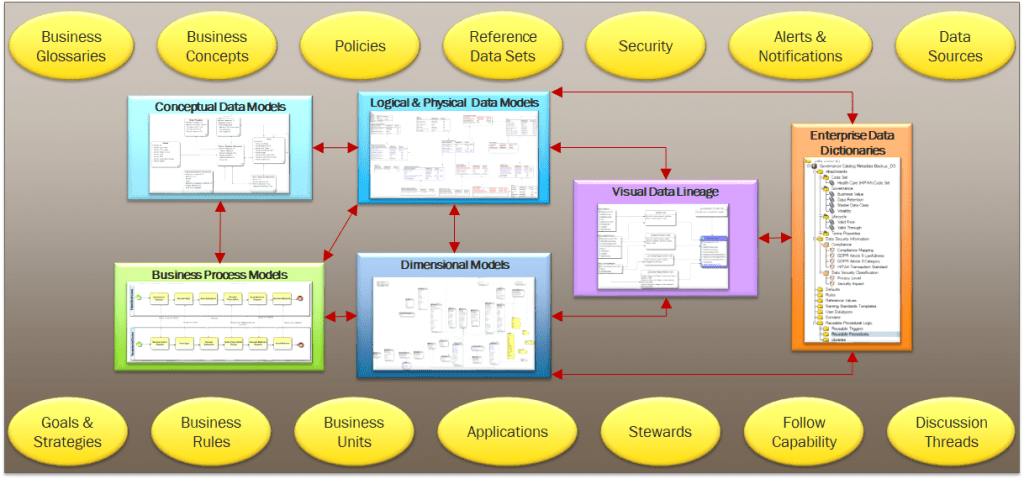 Ron Huizenga believes it’s possible for an organization to reach an enlightened state where users can “understand the journey of their data through the entire organization.” That entails knowing when the data was created, the processes that use it, being aware of how it’s transformed on its way through the organization, and ultimately, knowing when it’s reached the end of its lifecycle. “If I structure things correctly, it’s like pulling on a thread and being able to see all the other places where it’s attached.” That goal of a “global vision” is what drives Idera toward a process of continual innovation, he said.
Ron Huizenga believes it’s possible for an organization to reach an enlightened state where users can “understand the journey of their data through the entire organization.” That entails knowing when the data was created, the processes that use it, being aware of how it’s transformed on its way through the organization, and ultimately, knowing when it’s reached the end of its lifecycle. “If I structure things correctly, it’s like pulling on a thread and being able to see all the other places where it’s attached.” That goal of a “global vision” is what drives Idera toward a process of continual innovation, he said.
Huizenga is Senior Product Manager for Enterprise Architecture and Modeling for IDERA ER/Studio product suite, and the author of Battle the Dark Side of Data Governance. He and Joy Ruff, Product Marketing Manager for ER/Studio, spoke with DATAVERSITY® about recent changes and additions to Idera’s group of products.
A Suite of Data Management Tools
Ruff said after a strategic re-positioning, the company differentiates between the umbrella company and the database tools suite, with the database tools in all caps (IDERA), and the corporate entity now called “Idera, Inc.” “It’s still Idera, but there’s a little bit of branding differentiation within our different business lines.”
A little over two years ago, Idera, Inc. acquired Embarcadero Technologies, she said. The Embarcadero acquisition brought in application development tools under the RAD Studio family, “and they moved the database tools — ER/Studio and DB PowerStudio — under the IDERA brand.” Since then, they have also acquired TestRail, Ranorex, Sencha, AquaFold, Whole Tomato, and Froala, as well as Webyog, featuring MySQL database tools. “So Idera, which used to be one brand with primarily SQL Server-based database tools, is now Idera, Inc., with three business units.”
They still provide foundational business database tools, but these have been expanded beyond SQL Server to include a broad range of multi-platform products. “Our application development family, with the Embarcadero and Sencha products,” is the second unit, and the test management business unit, which includes Ranorex and TestRail, is the third, Ruff said. “More capabilities, more functionality,” addressing a variety of different market needs, but all still focused on developing databases, and developing and testing applications that access those databases.
Huizenga sees these changes as an evolutionary step: “It’s about recognizing that you have to set up your business lines and look after your target market in those particular business lines.” Historically, organizations didn’t understand what they had in their environments, and industry trends have pulled attention to other areas.
“In the mid-to-late ’90s, everybody started chasing the shiny ball of technology,” he said, and the focus became rapid development. “People stopped thinking about the importance of data.” Then a number of data breaches later, “They suddenly realized they’d thrown the baby out with the bathwater,” forcing a refocus on understanding the importance of Data Architecture, he said.
ER/Studio: A Starting Place
Huizenga said that the tools in ER/Studio are a good place for an organization to start getting a handle on understanding their data. “It really helps companies wherever they are in the maturation curve.” ER/Studio can introduce Data Modeling and Process Modeling, “and then bring them up to the full-blown Enterprise Architecture, and ultimately Data Governance, when they have all the pillars in place.”
Ruff said, “ER/Studio doesn’t do the Data Governance for you,” but Data Governance can’t be done without an Enterprise Architecture solution like ER/Studio as a foundation, “because if you’re not managing your data at the low level, you can’t manage it at a higher level,” she said.
Having a complete model of the data gives business users access to that global vision they need and a thorough understanding of the value of that data. “It’s extremely important that every single thing that an organization does has a data representation and a process representation,” in the model, “because it’s really through the modeling that we are able to improve our business processes, improve our data quality, and everything else,” said Huizenga.
Ruff agreed that it’s essential to share a common understanding of all data sources and how they are tied together because, “If you can’t find it, it’s no good. If you do have it, and you don’t know what it means, it’s still no good.”
How ER/Studio Works
“You take a high-powered tool like ER/Studio and point it at the data landscape, you bring all the data specifications back, and you can now start to rationalize and map out the entire environment,” said Huizenga. Building on that map, business processes are tied in, component architectures and business glossaries are added, “and most importantly, you’re able to communicate that out to all the business stakeholders,” bringing the whole global picture together, he said.
Typical Metadata Repositories without process models are available, but lack the ability to provide a comprehensive picture. “It’s like trying to find out where you’re going using the Yellow Pages, rather than using Google Maps.” Navigating through a changing data landscape, mapping business processes across the enterprise, and tying those processes back to the data throughout its lifecycle is challenging enough, he said, “But what good is a Metadata Repository without the pictures and the diagrams to show how things are tied together?”

Image created by Ron Huizenga, IDERA
Huizenga said that ER/Studio is not just a data and Enterprise Architecture Modeling tool, “It’s a data and Enterprise Architecture platform.” It plays well with any set of data tools as a capable, extensible suite. The ER/Studio environment has REST APIs built in, and the ability to import from ETL sources, “So you can still have your specialty metadata management tool or your specialty data analytics tool separate, but have the visibility to see those from within the modeling tool,” said Ruff.
Process Modeling: Compliance Made Visual
Their most recent major release was ER/Studio 17, “which introduced an update to our ER/Studio Business Architect tool, with full BPMN 2.0 compliance,” a feature that can validate models against a particular set of specifications. “For companies that want to follow those guidelines very strictly, we can validate their models against those specifications down to the letter,” she said.
Huizenga added that their customers in the pharmaceutical industry as well as other highly regulated industries rely on ER/Studio for all of their Process Modeling. “The General Data Protection Regulation in particular includes a directive to incorporate privacy by design and default,” something that organizations should be doing whether there are regulations compelling them to do so or not, he said.
The consequences of non-compliance can be great, so it’s vital to fully understand how regulations affect business practices. “You will need to verify that the safeguards you have in place are indeed sufficient, rather than just assuming they meet the requirements.” Compliance is an active process and it’s imperative that companies implement the appropriate protections proactively. “The government doesn’t care if that information is hiding in a Data Lake and I don’t know where it is. If I’m in possession of it, I’m responsible for it,” he said.
Enlightenment is Possible
Reaching that enlightened state of understanding about your data is possible, even if you’re building Data Governance from the ground up. Ruff describes it as a series of layers, with Data Architecture on the bottom as the solid foundation. Servers and storage capacity — technical architecture — comes next, then Applications and Business Architecture, “and across all of that is your enterprise enablement, so once you’ve got your enterprise set up, you can build your governance on top of that.”
Huizenga added that product updates are done regularly on a semi-annual basis, if not more often, as a result of customer requests for features, and to strengthen the foundation of the product. Often a customer will request something, “And it’s already in the queue,” said Ruff. Huizenga added: “Just like organizations need to reinvest in their technical architecture, that’s what we’re doing as we move forward.”
Photo Credit: madpixblue/Shutterstock.com
